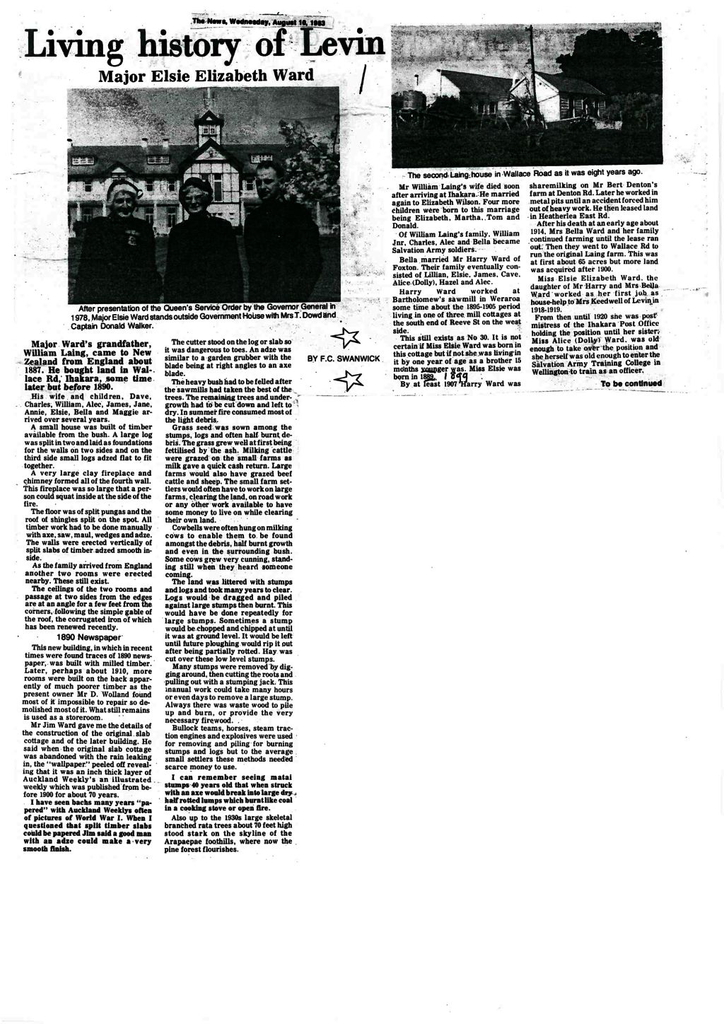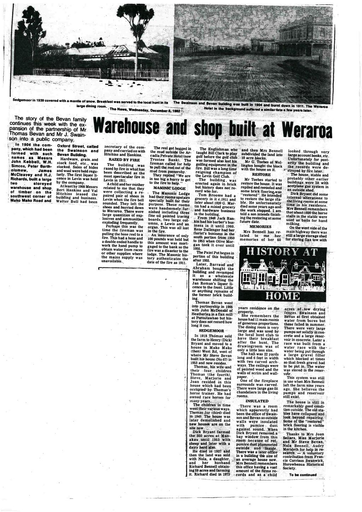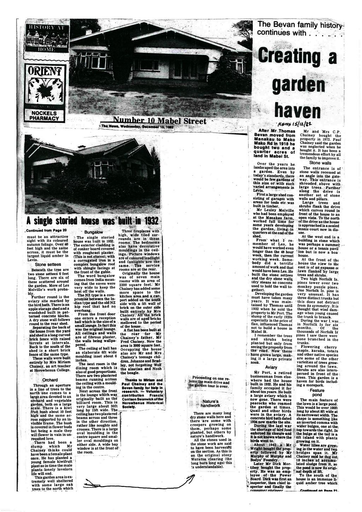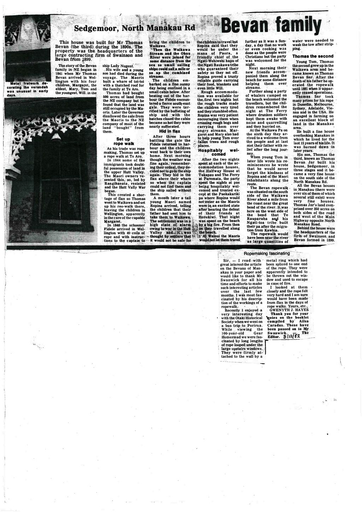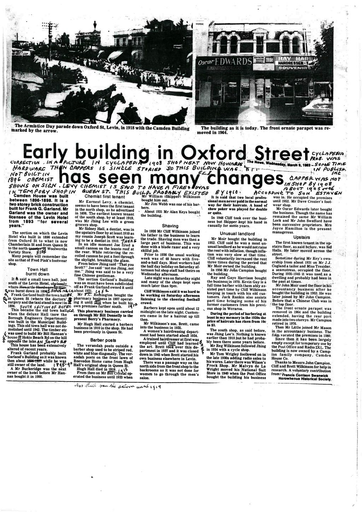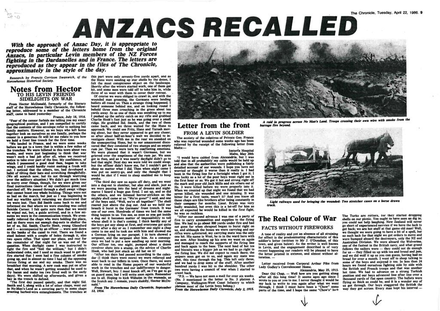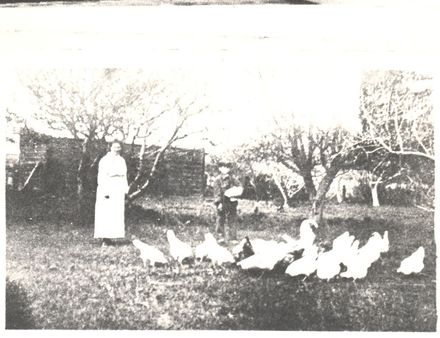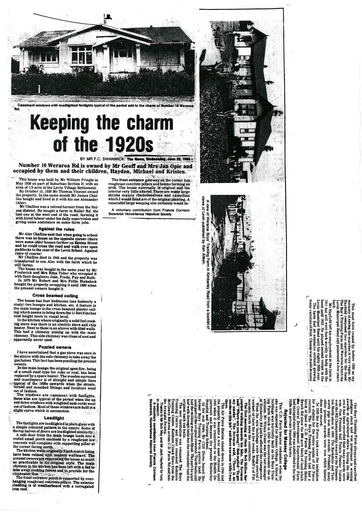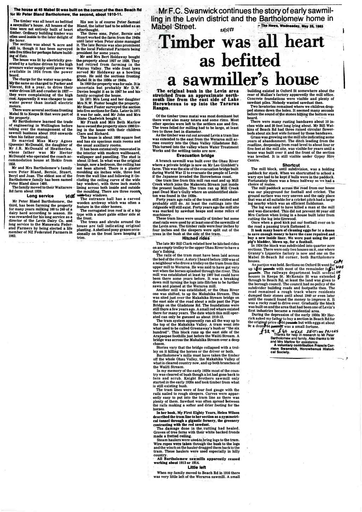Major Elsie Elizabeth Ward
- Description
 His wife and children, Dave, Charles, William, Alec, James, Jane, Annie, Elsie, Bella and Maggie arrived over several years.
His wife and children, Dave, Charles, William, Alec, James, Jane, Annie, Elsie, Bella and Maggie arrived over several years. A small house was built of timber available from the bush. A large log was split in two and laid as foundations for the walls on two sides and on the third side small logs adzed flat to fit together.
A very large clay fireplace and chimney formed all of the fourth wall. This fireplace was so large that a person could squat inside at the side of the fire. The floor was of split pungas and the roof of shingles split on the spot. All timber work had to be done manually with axe, saw, maul, wedges and adze. The walls were erected vertically of split slabs of timber and adzed smooth inside.
As the family arrived from England another two rooms were erected nearby. These still exist.The ceilings of the two rooms and passage at two sides from the edges are at an angle for a few feet from the corners, following the simple gable of the roof, the corrugated iron of which has been renewed recently.
1890 Newspaper
This new building, in which in recent times were found traces of 1890 newspaper, was built with milled timber. Later, perhaps about 1910, more rooms were built on the back apparently of much poorer timber as the present owner Mr D. Wolland found most of it impossible to repair so demolished most of it. What still remains is used as a storeroom.
Mr Jim Ward gave me the details of the construction of the original slab cottage and of the later building. He said when the original slab cottage was abandoned with the rain leaking in, the “wallpaper” peeled off revealing that it was an inch thick layer of Auckland Weekly’s an illustrated weekly which was published from before 1900 for about 70 years.
I have seen bachs many years “papered” with Auckland Weeklys often of pictures of World War 1. When I questioned that split timber slabs could be papered Jim said a good man with an adze could make a very smooth finish.
The cutter stood on the log or lab so it was dangerous to toes. An adze was similar to a garden grubber with the blade being at right angles to an axe blade.
The heavy bush had to be felled after the sawmills had taken the best of the trees. The remaining trees and undergrowth had to be cut down and left to dry. In summer fire consumed most of the light debris.
Grass seed was sown among the stumps, logs and often half burnt debris. The grass grew well at first being fertilized by the ash. Milking cattle were grazed on the small farms as milk gave a quick cash return. Large farms would also have grazed beef cattle and sheep. The small farm settlers would often have to work on large farms, clearing the land, on road work or any other work available, to have some money to live on while clearing their own land.
Cowbells were often hung on milking cows to enable them to be found amongst the debris, half burnt growth and even in the surrounding bush. Some cows grew very cunning, standing still when they hard someone coming.
The land was littered with stumps and logs and took many years to clear. Logs would be dragged and piled against large stumps then burnt. This would have been done repeatedly for large stumps. Sometimes a stump would be chopped and chipped at until it was at ground level. It would be left until future ploughing would rip it out after being partially rotted. Hay was cut over these low level stumps.
Many stumps were removed by digging around, then cutting the roots and pulling out with a stumping jack. This manual work could take many hours or even days to remove a large stump. Always there was waste wood to pile up and burn, or provide the very necessary firewood.
Bullock teams, horses, steam traction engines and explosives were used for removing and piling up for burning stumps and logs but to the average small settlers these methods needed scarce money to use.
I can remember seeing matai stumps 40 years old that when struck with an axe would break into large dry half rotted lumps which burnt like coal in a cooking stove or open fire.
Also up to the 1930s large skeletal branched rata trees about 70 feet high stood stark on the skyline of the Arapaepae foothills, where now the pine forest flourishes.
Mr William Laing’s wife died soon after arriving at Ihakara. He married again to Elizabeth Wilson. Four more children were born to this marriage being Elizabeth, Martha, Tom and Donald.
Of William Laing’s family, William Jnr, Charles, Alec and Bella became Salvation Army soldiers.
Bella married Mr Harry Ward of Foxton. Their family eventually consisted of Lillian, Elsie, James, Cave, Alice (Dolly), Hazel and Alec.
Harry Ward worked at Bartholomew’s sawmill in Weraroa some time about the 1895-1905 period living in one of three mill cottages at the south end of Reeve St on the west side.
This still exists as No.30. It is not certain if Miss Elsie Ward was born in this cottage but if not, she was living in it by one year of age as a brother 15 months younger [sic] was. Miss Elsie was born in 1889 [1899].
By at least 1907 Harry Ward was share milking on Mr Bert Denton’s farm at Denton Rd. Later he worked in metal pits until an accident forced him out of heavy work. He then leased land in Heatherlea East Rd.
After his death at an early age about 1914, Mrs Bella Ward and her family continued farming until the lease ran out. Then they went to Wallace Road to run the original Laing farm. This was at first about 65 acres but more land was acquired after 1900.
 Miss Elsie Elizabeth Ward, the daughter of Mr Harry and Mrs Bella Ward worked as her first job as house-help to Mrs Keedwell of Levin in 1918-1919.
Miss Elsie Elizabeth Ward, the daughter of Mr Harry and Mrs Bella Ward worked as her first job as house-help to Mrs Keedwell of Levin in 1918-1919. From then until 1920 she was post mistress of the Ihakara Post Office holding the position until her sister Miss Alice (Dolly) Ward, was old enough to take over the position and she herself was old enough to enter the Salvation Army Training College in Wellington to train as an officer.
Identification
- Date
- August 10, 1983
Taxonomy
- Community Tags

